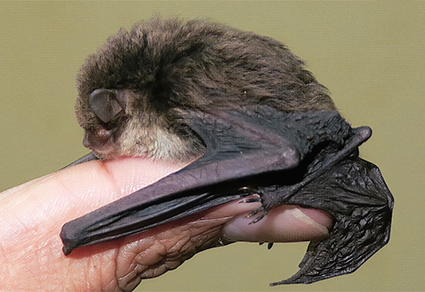Abstract
Thick-thumbed bats of the genus Glischropus are currently composed of four recognized species from Southeast Asia, two of which were described in recent times. Among these species, G. aquilus is endemic to Sumatra, G. javanus is restricted to western Java, whereas G. bucephalus is widely distributed north to the Isthmus of Kra and G. tylopus is widespread south to this zoogeographic boundary. Two recently collected Glischropus specimens from Meghalaya state in north-eastern India extend the known distribution range of the genus westward into South Asia by ca. 1000 km. Morphological examination of these specimens and comparison with all known species in this genus revealed marked differences in colouration, dental characters and bacular traits. We therefore describe the Meghalaya specimens as a new species. The discovery of the new species from a forest patch adjacent to Nongkhyllem Wildlife Sanctuary from where another specialized bamboo-dwelling species (Eudiscopus denticulus) was reported recently also underscore the importance of the area from a conservation point of view.
References
Bates, P.J.J. & Harrison, D.L. (1997) Bats of the Indian Subcontinent. Harrison Zoological Museum, Sevenoaks, 258 pp.
Blanford, W.T. (1888-91) The Fauna of British India, Mammalia. Taylor and Francis, London, 617 pp. https://doi.org/10.5962/bhl.title.100745
Bouillard, N. & Francis, C.M. (2021) Glischropus tylopus. The IUCN Red List of Threatened Species 2021: e.T81187867A22105878. https://doi.org/10.2305/IUCN.UK.2021-2.RLTS.T81187867A22105878.en
Burgin, C.J., Wilson, D.E., Mittermeier, R.A., Rylands, A.B., Lacher, T.E. & Sechrest, W. (2020) Illustrated checklist of the mammals of the world. Vol 2. Eulipotyphla to Carnivora. Lynx Edicions, Barcelona, 535 pp.
Champion, H.G. & Seth, S.K. (1968) A revised survey of the forest types of India. Manager of Publications, Government of India, New Delhi, 404 pp.
Csorba, G. (2011) A new species of Glischropus from Cambodia (Mammalia: Chiroptera: Vespertilionidae). Zootaxa, 2925 (1), 41–48. https://doi.org/10.11646/zootaxa.2925.1.4
Csorba, G., Görföl, T., Wiantoro, S., Kingston, T., Bates, P.J.J. & Huang, J.C. (2015) Thumb-pads up—a new species of thick-thumbed bat from Sumatra (Chiroptera: Vespertilionidae: Glischropus). Zootaxa, 3980 (2), 267–278. https://doi.org/10.11646/zootaxa.3980.2.7
Csorba, G. & Furey, N.M. (2022) From greener times: A new species of thick-thumbed Myotis from Phnom Penh, Cambodia. Acta Zoologica Academiae Scientiarum Hungaricae, 68, 85–97. https://doi.org/10.17109/AZH.68.1.85.2022
Denzinger, A. & Schnitzler, H.U. (2013) Bat guilds, a concept to classify the highly diverse foraging and echolocation behaviors of microchiropteran bats. Frontiers in Physiology, 1–15. https://doi.org/10.3389/fphys.2013.00164
Görföl, T., Hutson, A.M., Sinaga, U., Suyanto, A., Kingston, T. & Csorba, G. (2016) Glischropus javanus. IUCN Red List of Threatened Species, 2016, e.T9247A22106075. https://doi.org/10.2305/IUCN.UK.2016-2.RLTS.T9247A22106075.en
Heaney, L.R., Balete, D.S., Alviola, P., Rickart, E.A. & Ruedi, M. (2012) Nyctalus plancyi and Falsistrellus petersi (Chiroptera: Vespertilionidae) from northern Luzon, Philippines: ecology, phylogeny, and biogeographic implications. Acta Chiropterologica, 14, 265–278. https://doi.org/10.3161/150811012X661602
Kruskop, S.V. (2013) Bats of Vietnam. Checklist and an identification manual. Russian Academy of Sciences, Moscow, 299 pp.
Kruskop, S.V. (2019) The bacular of bats from Indochina: serotines and pipistrelles (Chiroptera: Vespertilionidae: Vespertilioninae). Plecotus et al., 22, 88–103.
Koubinova, D., Irwin, N., Hulva, P., Koubek, P. & Zima, J. (2013) Hidden diversity in Senegalese bats and associated findings in the systematics of the family Vespertilionidae. Frontiers in Zoology, 10, 48. https://doi.org/10.1186/1742-9994-10-48
Norberg, U.M. & Rayner, J.M.V. (1987) Ecological morphology and flight in bats (Mammalia; Chiroptera): wing adaptations, flight performance, foraging strategy and echolocation. Philosophical Transactions of the Royal Society of London, Series B, 316, 335–427. https://doi.org/10.1098/rstb.1987.0030
Núñez, S.F., López-Baucells, A., Rocha, R., Farneda, F.Z., Bobrowiec, P.E.D., Palmeirim, J.M. & Meyer, C.F.J. (2019) Echolocation and stratum preference: key trait correlates of vulnerability of insectivorous bats to tropical forest fragmentation. Frontiers in Ecology and Evolution, 7, 373. https://doi.org/10.3389/fevo.2019.00373
Saikia, U., Chakravarty, R., Hegde, V.D., Meetei, A.B., Kruskop, S., Csorba, G. & Ruedi, M. (2021) First record of disk-footed bat, Eudiscopus denticulus (Osgood, 1932) (Chiroptera: Mammalia) from India with notes on its ecology and genetics. Revue suisse de Zoologie, 128, 187–198. https://doi.org/10.35929/RSZ.0044
Schneider, C.A., Rasband, W.S. & Eliceiri, K.W. (2012) NIH Image to ImageJ: 25 years of Image analysis. Nature Methods, 9, 671–675. https://doi.org/10.1038/nmeth.2089
Sikes, R.S. & Animal Care and Use Committee of the American Society of Mammalogists. (2016) 2016 Guidelines of the American Society of Mammalogists for the use of wild mammals in research and education. Journal of Mammalogy, 97, 663–688. https://doi.org/10.1093/jmammal/gyw078
Thomas, N.M., Duckworth, J.W., Douangboubpha, B., Williams, M. & Francis, C.M. (2013) A checklist of bats (Mammalia: Chiroptera) from Lao PDR. Acta Chiropterologica, 15, 193–260. https://doi.org/10.3161/150811013X667993


